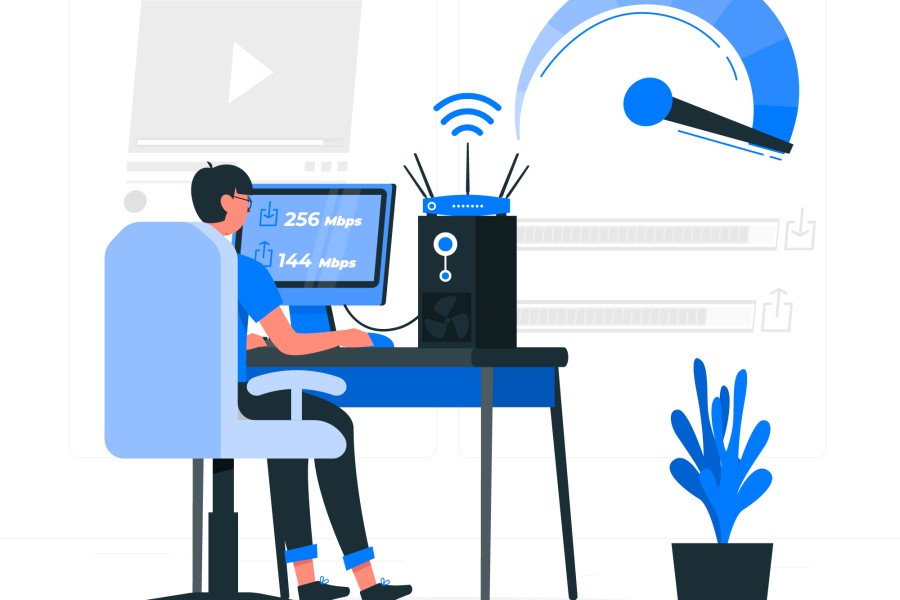There are a dozen of things in the internet world that a common man is not aware of. There are several terms that float in the digital market. But if you are someone who knows the basics of the internet, then you must have heard of bandwidth and latency. These two terminologies define a lot about the internet and hence, understanding them is of utmost importance if you wish to understand the digital world right. Both bandwidth and latency play significant roles in determining the quality of your online experience. So, let’s learn in detail about them and understand what is bandwidth, what is latency, and the prominent aspects of bandwidth vs latency.
Buy Airtel Wi-Fi with exciting benefits!
What is Bandwidth?
Have you ever wondered how the speed of the internet is determined? How do we come to a conclusion of 100Mbps, 50Mbps, etc? Well, this is where bandwidth comes into play. Bandwidth refers to the maximum rate of data transfer across a network or internet connection. You can think of it as the width of a pipe through which the data flows.
So, the wider the pipe, the higher the bandwidth, and eventually the more data can flow through it at once. This network bandwidth is usually measured in bits per second (bps), kilobits per second (kbps), megabits per second (Mbps), or even gigabits per second (Gbps).
What is Latency?
Latency, usually measured in milliseconds (ms), is the time it takes for data to travel from its source to its destination. It is often described as the delay between sending a request and receiving a response.
You often see a change in latency because it is influenced by various factors including the physical distance between devices, the quality of network infrastructure, and processing times at each end.
Key Differences Between Bandwidth and Latency
Now, let’s come to the most significant part – bandwidth vs latency. Here is the table provided for you to understand the differences between bandwidth and latency on the basis of various aspects.
| Aspect | Bandwidth | Latency |
| Nature of Measurement | Represents how much data can be transferred per unit of time. | Indicates how long it takes for data to travel from one point to another (usually source to destination) |
| Impact On Performance | Determines how fast you can download or upload large files, stream videos, or engage in online gaming. | Influences responsiveness. Lower latency means smoother experiences with online gaming, streaming, etc. |
| Usage | Useful for activities involving large data transfers such as downloading movies, transferring files, and backing up data | Useful for applications that require immediate feedback like online gaming, video calls, or accessing web pages. |
Recommended: A beginner’s guide to Broadband and how it works
How is Bandwidth Related to Latency?
There is no doubt that bandwidth and latency are different concepts, however, they are certainly interconnected to quite an extent and can influence each other.
Higher bandwidth doesn’t necessarily mean lower latency. However, it can indirectly contribute to reducing latency as you get more data and experience fewer delays in transmission.
On the other hand, high latency can lead to inefficiencies in bandwidth utilisation. For example – when data packets are lost or need to be retransmitted due to latency-related issues, the available bandwidth isn’t fully utilised.
No wonder it is important to have great broadband connectivity which offers low latency and better bandwidth.
Real-world applications of Bandwidth and Latency
Online Gaming
In the world of online gaming, bandwidth is important for downloading game updates, while reduced latency is helpful in the responsiveness during gameplay. Low latency means minimal delay between a player’s actions and their impact on the game world.
Video Streaming
Bandwidth is all about determining the resolution and quality of streamed videos, while latency affects the buffering time and playback interruptions. If your internet has a high bandwidth, it means you can enjoy smooth streaming. If it offers low latency, then it means it would reduce the time it takes for videos to start playing after clicking the play button.
Cloud Computing
Bandwidth plays a significant role in uploading and downloading data to and from cloud servers. Meanwhile, latency impacts the responsiveness of cloud-based applications, thereby, affecting user experience and productivity.
Also Read: Here’s why Airtel Broadband is the perfect choice for you!
Conclusion
So, in the world of internet connectivity, bandwidth and latency are two fundamental concepts that impact the quality of your online experiences. If you wish to have the best of both worlds, then it’s time for you to sign up with Airtel.
Airtel broadband services provide customers with high-speed connections and low-latency networks. Whether you are streaming your favourite shows, engaging in online gaming, or conducting business meetings, Airtel’s reliable broadband services offer you a great online experience. With Airtel, you can also upgrade your prepaid, postpaid and DTH connections.
Use the Airtel Thanks App to manage all your Airtel services, from recharge to new connections.


 Get App
Get App  Airtel Store
Airtel Store  Login
Login 



